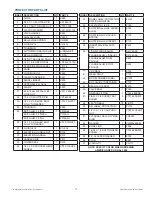
©Copyright Task Force Tips, Inc. 1999-2017
LIZ-010 December 26, 2017 Rev12
9
4.3 PRESSURE GAGE
There is a ¼” NPT female threaded hole adjacent to the elevation swivel, as shown in Figure 4.3. The hole is plugged from the
factory. If a pressure gage is desired, unscrew the plug and install the gage using pipe sealant. Make sure the gage does not interfere
with operation.
Pressure Gage Port 1/4" NPT
Handle Mounting Screw
Fig 4.3
Pressure Gage Port and Handle Mounting Screw
4.4 HANDLE INSTALLATION
The tiller handle is shipped loose from the monitor and must be installed to complete the installation process. When installing the
tiller handle, be sure to coat the threads of the mounting screw with the Loctite supplied in the hardware packet. Handle mounting
screw location is shown in Figure 4.3.
4.5 DRAINING RESIDUAL WATER
NOTICE
All monitors, valves and standpipes exposed to freezing conditions must be drained immediately
following use to prevent damage. To drain a standpipe, a drainage port must be opened
underground below the frost depth to keep water out of the standpipe until the next use.
All Protector station monitors are equipped with an automatic drain valve attached to a port located just above the valve seat and/
or lower seal. The automatic drain valve ensures the monitor is completely drained following use, which minimizes susceptibility
to damage from corrosion and freezing water. The drain valve seal membrane is designed to close automatically when pressure
exceeds 5 psi. When pressure drops below 5 psi, the seal membrane will open to allow drainage. If the automatic drain valve is
omitted or disabled, then the monitor must be manually drained after use to prevent damage.
5.0 OPERATION
5.1 VALVE OPERATION
For models equipped with a built-in valve, the fl ow is OFF when the valve handle is horizontal and ON when the handle is vertical.
Parts are manufactured so that the valve cannot be assembled out of phase. A position indicator shows the valves position as “OFF”
or “ON”. The position that the valve is normally left in will depend upon your particular location’s standard operating procedure.
Operate the valve slowly to reduce water hammer.






































